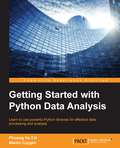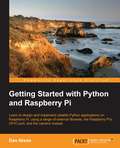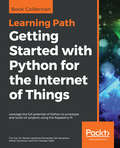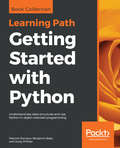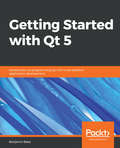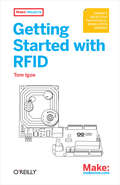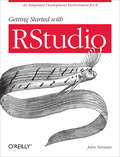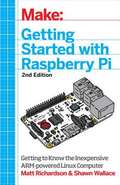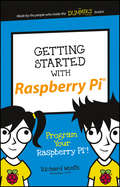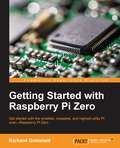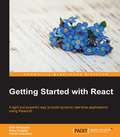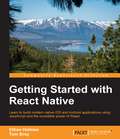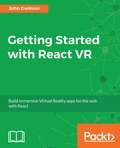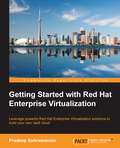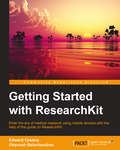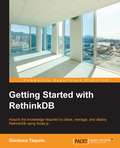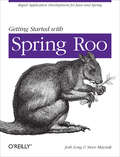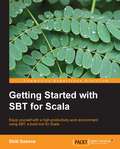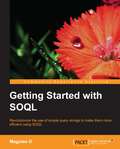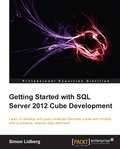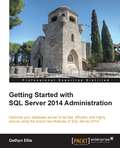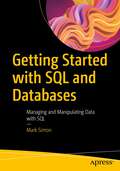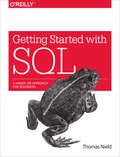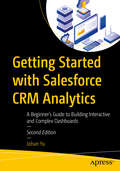- Table View
- List View
Getting Started with Python Data Analysis
by Phuong VothihongIf you are a Python developer who wants to get started with data analysis and you need a quick introductory guide to the python data analysis libraries, then this book is for you.
Getting Started with Python and Raspberry Pi
by Dan NixonLearn to design and implement reliable Python applications on the Raspberry Pi using a range of external libraries, the Raspberry Pis GPIO port, and the camera module About This Book * Learn the fundamentals of Python scripting and application programming * Design user-friendly command-line and graphical user interfaces * A step-by-step guide to learning Python programming with the Pi Who This Book Is For This book is designed for those who are unfamiliar with the art of Python development and want to get to know their way round the language and the many additional libraries that allow you to get a full application up and running in no time. What You Will Learn * Fundamentals of Python applications * Designing applications for multi-threading * Interacting with electronics and physical devices * Debugging applications when they go wrong * Packaging and installing Python modules * User interface design using Qt * Building easy to use command-line interfaces * Connecting applications to the Internet In Detail The Raspberry Pi is one of the smallest and most affordable single board computers that has taken over the world of hobby electronics and programming, and the Python programming language makes this the perfect platform to start coding with. The book will start with a brief introduction to Raspberry Pi and Python. We will direct you to the official documentation that helps you set up your Raspberry Pi with the necessary equipment such as the monitor, keyboard, mouse, power supply, and so on. It will then dive right into the basics of Python programming. Later, it will focus on other Python tasks, for instance, interfacing with hardware, GUI programming, and more. Once you get well versed with the basic programming, the book will then teach you to develop Python/Raspberry Pi applications. By the end of this book, you will be able to develop Raspberry Pi applications with Python and will have good understanding of Python programming for Raspberry Pi. Style and approach An easy-to-follow introduction to Python scripting and application development through clear conceptual explanations backed up by real-world examples on the Raspberry Pi.
Getting Started with Python for the Internet of Things: Leverage the full potential of Python to prototype and build IoT projects using the Raspberry Pi
by Tim Cox Srihari Yamanoor Sai Yamanoor Prof. Diwakar Vaish Dr. Steven FernandesBuild clever, collaborative, and powerful automation systems with the Raspberry Pi and Python.Key FeaturesCreate your own Pi-Rover or Pi-Hexipod robotsDevelop practical applications in Python using Raspberry PiBuild your own Jarvis, a highly advanced computerized AIBook DescriptionThis Learning Path takes you on a journey in the world of robotics and teaches you all that you can achieve with Raspberry Pi and Python.It teaches you to harness the power of Python with the Raspberry Pi 3 and the Raspberry Pi zero to build superlative automation systems that can transform your business. You will learn to create text classifiers, predict sentiment in words, and develop applications with the Tkinter library. Things will get more interesting when you build a human face detection and recognition system and a home automation system in Python, where different appliances are controlled using the Raspberry Pi. With such diverse robotics projects, you'll grasp the basics of robotics and its functions, and understand the integration of robotics with the IoT environment.By the end of this Learning Path, you will have covered everything from configuring a robotic controller, to creating a self-driven robotic vehicle using Python.Raspberry Pi 3 Cookbook for Python Programmers - Third Edition by Tim Cox, Dr. Steven Lawrence FernandesPython Programming with Raspberry Pi by Sai Yamanoor, Srihari YamanoorPython Robotics Projects by Prof. Diwakar VaishWhat you will learnBuild text classifiers and predict sentiment in words with the Tkinter libraryDevelop human face detection and recognition systemsCreate a neural network module for optical character recognitionBuild a mobile robot using the Raspberry Pi as a controllerUnderstand how to interface sensors, actuators, and LED displays workApply machine learning techniques to your modelsInterface your robots with BluetoothWho this book is forThis Learning Path is specially designed for Python developers who want to take their skills to the next level by creating robots that can enhance people’s lives. Familiarity with Python and electronics will aid understanding the concepts in this Learning Path.
Getting Started with Python: Understand key data structures and use Python in object-oriented programming
by Dusty Phillips Fabrizio Romano Benjamin BakaHarness the power of Python objects and data structures to implement algorithms for analyzing your data and efficiently extracting informationKey FeaturesTurn your designs into working software by learning the Python syntaxWrite robust code with a solid understanding of Python data structuresUnderstand when to use the functional or the OOP approachBook DescriptionThis Learning Path helps you get comfortable with the world of Python. It starts with a thorough and practical introduction to Python. You’ll quickly start writing programs, building websites, and working with data by harnessing Python's renowned data science libraries. With the power of linked lists, binary searches, and sorting algorithms, you'll easily create complex data structures, such as graphs, stacks, and queues. After understanding cooperative inheritance, you'll expertly raise, handle, and manipulate exceptions. You will effortlessly integrate the object-oriented and not-so-object-oriented aspects of Python, and create maintainable applications using higher level design patterns. Once you’ve covered core topics, you’ll understand the joy of unit testing and just how easy it is to create unit tests.By the end of this Learning Path, you will have built components that are easy to understand, debug, and can be used across different applications.This Learning Path includes content from the following Packt products:Learn Python Programming - Second Edition by Fabrizio RomanoPython Data Structures and Algorithms by Benjamin BakaPython 3 Object-Oriented Programming by Dusty PhillipsWhat you will learnUse data structures and control flow to write codeUse functions to bundle together a sequence of instructionsImplement objects in Python by creating classes and defining methodsDesign public interfaces using abstraction, encapsulation and information hidingRaise, define, and manipulate exceptions using special error objectsCreate bulletproof and reliable software by writing unit testsLearn the common programming patterns and algorithms used in PythonWho this book is forIf you are relatively new to coding and want to write scripts or programs to accomplish tasks using Python, or if you are an object-oriented programmer for other languages and seeking a leg up in the world of Python, then this Learning Path is for you. Though not essential, it will help you to have basic knowledge of programming and OOP.
Getting Started with Qt 5: Introduction to programming Qt 5 for cross-platform application development
by Benjamin BakaBegin writing graphical user interface(GUI) applications for building human machine interfaces with a clear understanding of key concepts of the Qt frameworkKey FeaturesLearn how to write, assemble, and build Qt application from the command lineUnderstand key concepts like Signals and Slots in QtBest practices and effective techniques for designing graphical user interfaces using Qt 5Book DescriptionQt is a cross-platform application framework and widget toolkit that is used to create GUI applications that can run on different hardware and operating systems. The main aim of this book is to introduce Qt to the reader. Through the use of simple examples, we will walk you through building blocks without focusing too much on theory.Qt is a popular tool that can be used for building a variety of applications, such as web browsers, media players such as VLC, and Adobe Photoshop. Following Qt installation and setup, the book dives straight into helping you create your first application.You will be introduced to Widgets, Qt's interface building block, and the many varieties that are available for creating GUIs. Next, Qt's core concept of signals and slots are well illustrated with sufficient examples. The book further teaches you how to create custom widgets, signals and slots, and how to communicate useful information via dialog boxes. To cap everything off, you will be taken through writing applications that can connect to databases in order to persist data.By the end of the book, you should be well equipped to start creating your own Qt applications and confident enough to pick up more advanced Qt techniques and materials to hone your skills.What you will learnSet up and configure your machine to begin developing Qt applications Discover different widgets and layouts for constructing UIsUnderstand the key concept of signals and slots Understand how signals and slots help animate a GUIExplore how to create customized widgets along with signals and slots Understand how to subclass and create a custom windows applicationUnderstand how to write applications that can talk to databases.Who this book is forAnyone trying to start development of graphical user interface application will find this book useful. One does not need prior exposure to other toolkits to understand this book. In order to learn from this book you should have basic knowledge of C++ and a good grasp of Object Oriented Programming. Familiarity with GNU/Linux will be very useful though it's not a mandatory skill.
Getting Started with RFID: Identify Objects in the Physical World with Arduino
by Tom IgoeIf you want to experiment with radio frequency identification (RFID), this book is the perfect place to start. All you need is some experience with Arduino and Processing, the ability to connect basic circuits on a breadboard with jumper wire—and you’re good to go. You’ll be guided through three hands-on projects that let you experience RFID in action.RFID is used in various applications, such as identifying store items or accessing a toll road with an EZPass system. After you build each of the book’s projects in succession, you’ll have the knowledge to pursue RFID applications of your own.Use Processing to get a sense of how RFID readers behaveConnect Arduino to an RFID reader and discover how to use RFID tags as keysAutomate your office or home, using RFID to turn on systems when you’re present, and turn them off when you leaveGet a complete list of materials you need, along with code samples and helpful illustrationsTackle each project with easy-to-follow explanations of how the code works
Getting Started with RStudio: An Integrated Development Environment for R
by John VerzaniDive into the RStudio Integrated Development Environment (IDE) for using and programming R, the popular open source software for statistical computing and graphics. This concise book provides new and experienced users with an overview of RStudio, as well as hands-on instructions for analyzing data, generating reports, and developing R software packages.The open source RStudio IDE brings many powerful coding tools together into an intuitive, easy-to-learn interface. With this guide, you’ll learn how to use its main components—including the console, source code editor, and data viewer—through descriptions and case studies. Getting Started with RStudio serves as both a reference and introduction to this unique IDE.Use RStudio to provide enhanced support for interactive R sessionsClean and format raw data quickly with several RStudio componentsEdit R commands with RStudio’s code editor, and combine them into functionsEasily locate and use more than 3,000 add-on packages in R’s CRAN serviceDevelop and document your own R packages with the code editor and related componentsCreate one-click PDF reports in RStudio with a mix of text and R output
Getting Started with Raspberry Pi
by Shawn Wallace Matt RichardsonWhat can you do with the Raspberry Pi, a $35 computer the size of a credit card? All sorts of things! If you're learning how to program, or looking to build new electronic projects, this hands-on guide will show you just how valuable this flexible little platform can be. This book takes you step-by-step through many fun and educational possibilities. Take advantage of several preloaded programming languages. Use the Raspberry Pi with Arduino. Create Internet-connected projects. Play with multimedia. With Raspberry Pi, you can do all of this and more. Get acquainted with hardware features on the Pi's board Learn enough Linux to move around the operating system Pick up the basics of Python and Scratch--and start programming Draw graphics, play sounds, and handle mouse events with the Pygame framework Use the Pi's input and output pins to do some hardware hacking Discover how Arduino and the Raspberry Pi complement each other Integrate USB webcams and other peripherals into your projects Create your own Pi-based web server with Python
Getting Started with Raspberry Pi
by Richard WentkA technology book for kids! Do you want to learn how computers work? This book introduces you to the world of computing with the Raspberry Pi - the small, inexpensive, and super-cool microcomputer that teaches real tech skills. Use the Pi to create things while learning all about computers, from the inside out! Start it up --get your Raspberry Pi set up, configured, and ready for action Create music --start the party using Sonic Pi to record your own songs Game on --combine Python® and Minecraft® and start programming your own video game world.
Getting Started with Raspberry Pi Zero
by Richard GrimmettGet started with the smallest, cheapest, and highest-utility Pi ever--Raspberry Pi Zero About This Book * Get started with Raspberry Pi Zero and put all of its exciting features to use * Create fun games and programs with little or no programming experience * Learn to use this super-tiny PC to control hardware and software for work, play, and everything else Who This Book Is For This book is for hobbyists and programmers who are taking their first steps toward using Raspberry Pi Zero. No programming experience is required, although some Python programming experience might be useful. What You Will Learn * Understand how to initially download the operating system and set up Raspberry Pi Zero * Find out how to control the GPIO pins of Raspberry Pi Zero to control LED circuits * Get to grips with adding hardware to the GPIO to control more complex hardware such as motors * Add USB control hardware to control a complex robot with 12 servos * Include speech recognition so that projects can receive commands * Enable the robot to communicate with the world around it by adding speech output * Control the robot from a distance and see what the robot is seeing by adding wireless communication * Discover how to build a Robotic hand and a Quadcopter In Detail Raspberry Pi Zero is half the size of Raspberry Pi A, only with twice the utility. At just three centimeters wide, it packs in every utility required for full-fledged computing tasks. This practical tutorial will help you quickly get up and running with Raspberry Pi Zero to control hardware and software and write simple programs and games. You will learn to build creative programs and exciting games with little or no programming experience. We cover all the features of Raspberry Pi Zero as you discover how to configure software and hardware, and control external devices. You will find out how to navigate your way in Raspbian, write simple Python scripts, and create simple DIY programs. Style and approach This is a practical and fun ?getting started? tutorial that will guide you through everything new that the Raspberry Pi has to offer.
Getting Started with React
by Danillo Corvalan Doel Sengupta Manu SinghalA light but powerful way to build dynamic real-time applications using ReactJS About This Book * Learn how to develop powerful JavaScript applications using ReactJS * Integrate a React-based app with an external API (Facebook login) while using React components, with the Facebook developer app * Implement the Reactive paradigm to build stateless and asynchronous apps with React Who This Book Is For This book is for any front-end web or mobile-app developer who wants to learn ReactJS. Knowledge of basic JavaScript will give you a good head start with the book. What You Will Learn * Understand the ReactJS basics through an overview * Install and create your first React component * Refactor the ReactJS component using JSX * Integrate your React application with the Facebook login and Graph API, then fetch data from your liked pages in Facebook and display them in a browser * Handle UI elements events with React, respond to users input, and create stateful components * Use some core lifecycle events for integration and find out about ES6 syntaxes in the React world * Understand the FLUX architecture and create an application using FLUX with React * Make a component more reusable with mixins and validation helpers and structure your components properly * Explore techniques to test your ReactJS code * Deploy your code using webpack and Gulp In Detail ReactJS, popularly known as the V (view) of the MVC architecture, was developed by the Facebook and Instagram developers. It follows a unidirectional data flow, virtual DOM, and DOM difference that are generously leveraged in order to increase the performance of the UI. Getting Started with React will help you implement the Reactive paradigm to build stateless and asynchronous apps with React. We will begin with an overview of ReactJS and its evolution over the years, followed by building a simple React component. We will then build the same react component with JSX syntax to demystify its usage. You will see how to configure the Facebook Graph API, get your likes list, and render it using React. Following this, we will break the UI into components and you'll learn how to establish communication between them and respond to users input/events in order to have the UI reflect their state. You'll also get to grips with the ES6 syntaxes. Moving ahead, we will delve into the FLUX and its architecture, which is used to build client-side web applications and complements React's composable view components by utilizing a unidirectional data flow. Towards the end, you'll find out how to make your components reusable, and test and deploy them into a production environment. Finally, we'll briefly touch on other topics such as React on the server side, Redux and some advanced concepts. Style and approach The book follows a step-by-step, practical, tutorial approach with examples that explain the key concepts of ReactJS. Each topic is sequentially explained and contextually placed to give sufficient details of ReactJS.
Getting Started with React Native
by Tom Bray Ethan HolmesLearn to build modern native iOS and Android applications using JavaScript and the incredible power of React About This Book * Learn to design and build a fully-featured application using the newest cutting-edge framework from Facebook * Leverage your JavaScript skills to become a native app developer * Develop custom UI components, implement smooth navigation, and access native features such as geolocation and local storage Who This Book Is For This book is for web developers who want to learn to build fast, good-looking, native mobile applications using the skills they already have. If you already have some JavaScript knowledge or are using React on the web, then you will be able to quickly get up and running with React Native for iOS and Android. What You Will Learn * Set up the React Native environment on both devices and emulators * Gain an in-depth understanding of how React Native works behind the scenes * Write your own custom native UI components * Learn the ins and outs of screen navigation * Master the art of layout and styles * Work with device-exclusive data such as geolocation * Develop native modules in Objective-C and Java that interact with JavaScript * Test and deploy your application for a production-ready environment In Detail React Native is a game-changing approach to hybrid mobile development. Web developers can leverage their existing skills to write mobile applications in JavaScript that are truly native without using cross-compilation or web views. These applications have all of the advantages of those written in Objective-C or Java, combined with the rapid development cycle that JavaScript developers are accustomed to. Web developers who want to develop native mobile applications face a high barrier to entry, because they are forced to learn platform-specific languages and frameworks. Numerous hybrid technologies have tried to simplify this process, but have failed to achieve the performance and appearance that users expect. This book will show you all the advantages of true native development that React Native has without the steep learning curve, leveraging the knowledge you already have. We do this by getting you up and running quickly with a sample application. Next, we'll introduce you to the fundamentals of creating components and explain how React Native works under the hood. Once you have established a solid foundation, you will dive headfirst into developing a real-world application from start to finish. Along the way, we will demonstrate how to create multiple screens and navigate between them,use layout and style native UI components, and access native APIs such as local storage and geolocation. Finally, we tackle the advanced topic of Native modules, which demonstrates that there are truly no limits to what you can do with React Native. Style and approach This book provides a simple and easy way to build mobile applications in JavaScript. Each topic takes you through the life cycle of creating a fully-functional native app, with detailed explanations of the entire process.
Getting Started with React VR
by John GwinnerCreate amazing 360 and virtual reality content that runs directly in your browsers with JavaScript and React VR 2.0 About This Book • A practical guide to developing virtual reality experiences targeting web and mobile browsers • Create customized 3D graphics for your virtual reality experiences with Three.js • Explore the ReactVR library to create objects that seem real and see how they move in the Virtual world • Import free models into VR and include those in your code Who This Book Is For This book is for web developers who want to use their existing skill set of HTML, CSS, and JavaScript to create virtual reality experiences. What You Will Learn • Use Blender 2.79 to make virtual reality objects for Web VR. • Import free models into VR and how to include those in your code • Build a Virtual Museum with interactive art pieces • Create your first VR App and customizing it • Build animations by procedurally changing an object's position, using timers and Animated APIs • Incorporate React Native code and JavaScript code in your VR world In Detail This book takes you on a journey to create intuitive and interactive Virtual Reality experiences by creating your first VR application using React VR 2.0.0. It starts by getting you up to speed with Virtual Reality (VR) and React VR components. It teaches you what Virtual Reality (VR) really is, why it works, how to describe 3D objects, the installation of Node.js (version 9.2.0) and WebVR browser. You will learn 3D polygon modeling, texturing, animating virtual objects and adding sound to your VR world. You will also discover ways to extend React VR with new features and native Three.js. You will learn how to include existing high-performance web code into your VR app. This book will also take you through upgrading and publishing your app. By the end of this book, you'll have a deep knowledge of Virtual Reality and a full-fledged working VR app to add to your profile! Style and approach A step-by-step practical guide to help readers build their first VR application.
Getting Started with Red Hat Enterprise Virtualization
by Pradeep SubramanianIf you are a system administrator who is interested in implementing and managing open source virtualization infrastructures, this is the book for you. A basic knowledge of virtualization and basic Linux command line experience is needed.
Getting Started with ResearchKit
by Dhanush Balachandran Edward CessnaEnter the era of medical research using mobile devices with the help of this guide on ResearchKit! About This Book * Create a simple clinical research app using most aspects of ResearchKit * Build a simple survey with various data types with the results printed on the screen. * A step-by-step guide introducing Apple's ResearchKit and techniques to incorporate it into various apps. Who This Book Is For This book is aimed at medical researchers with basic iOS coding knowledge and iOS developers looking to create clinical research apps. What You Will Learn * Learn to create customized consent form * Get introduced to two backend services: a simple backend server using Sinatra and Sage Bridge * Build a custom task (a conditional survey example) and a navigable task * Get an Overview of ResearchKit's open source repository and App Core * Interaction with the hardware of the device including the gyro and the motion sensors * Learn the basics of this revolutionary technology * Get introduced to the barebones app and learn to write your first code In Detail ResearchKit is an open source software development framework from Apple that lets you easily create mobile applications for clinical research studies. ResearchKit provides you the ability to orchestrate the administration of tasks and recording of the results. ResearchKit provides tasks in order to perform informed consent, active tasks, and surveys. Starting with the basics of the ResearchKit framework, this books walks you through the steps of creating iOS applications that could serve as the basis of a clinical research mobile app. This book will introduce readers to ResearchKit and how to turn your iPhone into into a clinical research tool. The book will start off by installing and building the research framework in line with the researcher's needs; during this, the reader will learn to embed ResearchKit in the application and create a small task. After this, the book will go a little deeper into creating modules for surveys, consents, and so on. The book will also cover the various aspects of privacy and security with regard to participant data, and how to build dashboards for visualizing medical data and results in line with the researcher's requirements: data backends, JSON serialization and deserialization, and so on. Readers will be able to fully utilize ResearchKit for medical research, will be able to get more and more patients to participate in their surveys, and will gain insights from the surveys using the dashboards created. Style and approach A hands-on guide with ample screenshots for you to follow and learn about ResearchKit. Each topic is explained sequentially and placed in context so that you can get a better understanding of every step in the process of creating clinical research apps.
Getting Started with RethinkDB
by Gianluca TiepoloAbsorb the knowledge required to utilize, manage, and deploy RethinkDB using Node.js About This Book * Make the most of this open source, scalable database--RethinkDB --to ease the construction of web applications * Run powerful queries using ReQL, which is the most convenient language to manipulate JSON documents with * Develop fully-fledged real-time web apps using Node.js and RethinkDB Who This Book Is For Getting Started with RethinkDB is ideal for developers who are new to RethinkDB and need a practical understanding to start working with it. No previous knowledge of database programming is required, although a basic knowledge of JavaScript or Node.js would be helpful. What You Will Learn * Download and install the database on your system * Configure RethinkDB's settings and start using the web interface * Import data into RethinkDB * Run queries using the ReQL language * Create shards, replicas, and RethinkDB clusters * Use an index to improve database performance * Get to know all the RethinkDB deployment techniques In Detail RethinkDB is a high-performance document-oriented database with a unique set of features. This increasingly popular NoSQL database is used to develop real-time web applications and, together with Node.js, it can be used to easily deploy them to the cloud with very little difficulty. Getting Started with RethinkDB is designed to get you working with RethinkDB as quickly as possible. Starting with the installation and configuration process, you will learn how to start importing data into the database and run simple queries using the intuitive ReQL query language. After successfully running a few simple queries, you will be introduced to other topics such as clustering and sharding. You will get to know how to set up a cluster of RethinkDB nodes and spread database load across multiple machines. We will then move on to advanced queries and optimization techniques. You will discover how to work with RethinkDB from a Node.js environment and find out all about deployment techniques. Finally, we'll finish by working on a fully-fledged example that uses the Node.js framework and advanced features such as Changefeeds to develop a real-time web application. Style and approach This is a step-by-step book that provides a practical approach to RethinkDB programming, and is explained in a conversational, easy-to-follow style.
Getting Started with Review Board
by Sandeep RawatThis book is a concise, to-the-point guide with a practical walkthrough of the code review workflow using the features present in Reviewboard. The various concepts and features are explained through screenshots so that even if you do not have a running installation of Reviewboard in front of you, you can still gain practical knowledge. This book is intended for web programmers or quality control staff who perform or participate in code reviews and who are using (or planning to use) Reviewboard for conducting code reviews. No prior knowledge of Reviewboard is assumed.
Getting Started with Roo: Rapid Application Development for Java and Spring
by Steve Mayzak Josh LongSpring Roo goes a step beyond the Spring Framework by bringing true Rapid Application Development to Java—just as Grails has done with Groovy. This concise introduction shows you how to build applications with Roo, using the framework's shell as an intelligent and timesaving code-completion tool. It's an ideal RAD tool because Roo does much of the tedious code maintenance.You'll get started by building a simple customer relationship management application, complete with step-by-step instructions and code examples. Learn how to control any part of the application with Roo's opt-in feature, while using this open source framework to automate the rest of the code.Set up a Spring application and working Maven build to see Roo in actionAddress persistence with JPA and the Neo4j graph database—and learn how Roo supports NoSQL databasesUse Roo’s database reverse-engineering feature to generate a data model from an existing schemaBuild Roo applications with Spring MVC, Spring WebFlow, Google Web Toolkit, Vaadin, and other web frameworksSecure and test your application
Getting Started with SBT for Scala
by Shiti SaxenaA practical and fast-paced guide, Getting Started with SBT for Scala walks you through the setup of Scala projects in SBT with sample code for common as well as critical scenarios.Getting Started with SBT for Scala is for developers working on Scala projects who are interested in learning and utilizing Simple Build Tool to manage the build process.
Getting Started with SOQL
by Magulan DThis is a practical tutorial-based guide on using the new SOQL language, aimed at Force.com developers. Each topic is discussed with the help of standard SOQL queries. If you are a Salesforce.com developer or administrator, this book will help you to avoid hitting limits set by Salesforce.com. For those of you who are preparing for advanced developer Salesforce.com certification, this book will also be particularly useful.
Getting Started with SQL Server 2012 Cube Development
by Simon LidbergAs a practical tutorial for Analysis Services, get started with developing cubes. "Getting Started with SQL Server 2012 Cube Development" walks you through the basics, working with SSAS to build cubes and get them up and running.Written for SQL Server developers who have not previously worked with Analysis Services. It is assumed that you have experience with relational databases, but no prior knowledge of cube development is required. You need SQL Server 2012 in order to follow along with the exercises in this book.
Getting Started with SQL Server 2014 Administration
by Gethyn EllisThis is an easytofollow handson tutorial that includes real world examples of SQL Server 2014's new features. Each chapter is explained in a stepbystep manner which guides you to implement the new technology. If you want to create an highly efficient database server then this book is for you. This book is for database professionals and system administrators who want to use the added features of SQL Server 2014 to create a hybrid environment, which is both highly available and allows you to get the best performance from your databases.
Getting Started with SQL and Databases: Managing and Manipulating Data with SQL
by Mark SimonLearn the basics of writing SQL scripts. Using Standard SQL as the starting point, this book teaches writing SQL in various popular dialects, including PostgreSQL, MySQL/MariaDB, Microsoft SQL Server, Oracle, and SQLite.The book starts with a general introduction to writing SQL and covers the basic concepts. Author Mark Simon then covers database principles, and how database tables are designed. He teaches you how to filter data using the WHERE clause, and you will work with NULL, numbers, dates, and strings. You will also understand sorting results using the ORDER BY clause, sorting by calculated columns, and limiting the number of results. By the end of the book, you will know how to insert and update data, and summarize data with aggregate functions and groups. Three appendices cover differences between SQL dialects, working with tables, and a crash course in PDO.What You Will LearnFilter, sort, and calculate dataSummarize data with aggregate functionsModify data with insert, update, and delete statementsStudy design principles in developing a databaseWho This Book Is ForDevelopers and analysts working with SQL, as well as web developers who want a stronger understanding of working with databases
Getting Started with SQL: A Hands-on Approach For Beginners
by Thomas NieldBusinesses are gathering data today at exponential rates and yet few people know how to access it meaningfully. If you’re a business or IT professional, this short hands-on guide teaches you how to pull and transform data with SQL in significant ways. You will quickly master the fundamentals of SQL and learn how to create your own databases.Author Thomas Nield provides exercises throughout the book to help you practice your newfound SQL skills at home, without having to use a database server environment. Not only will you learn how to use key SQL statements to find and manipulate your data, but you’ll also discover how to efficiently design and manage databases to meet your needs.You’ll also learn how to:Explore relational databases, including lightweight and centralized modelsUse SQLite and SQLiteStudio to create lightweight databases in minutesQuery and transform data in meaningful ways by using SELECT, WHERE, GROUP BY, and ORDER BYJoin tables to get a more complete view of your business dataBuild your own tables and centralized databases by using normalized design principlesManage data by learning how to INSERT, DELETE, and UPDATE records
Getting Started with Salesforce CRM Analytics: A Beginner’s Guide to Building Interactive and Complex Dashboards
by Johan YuDive into the intricate world of salesforce CRM Analytics and harness the power of interactive and complex dashboards. This book will empower you to unlock the full potential of Salesforce CRM Analytics and enhance your ability to generate meaningful insights for strategic decision-making. Developed by Salesforce to transcend the limitations of standard reports and dashboards, CRM Analytics introduces a new platform that requires a fresh perspective for those familiar with the traditional Salesforce platform. Using a hands-on approach, this step-by-step book unravels the complexities of CRM Analytics, guiding you through the process of acquiring data from the Salesforce platform, importing external data like CSV files, and preparing the data for dashboard creation. You’ll also learn to build dashboards from scratch, explore lenses, and delve into the depths of SAQL (Salesforce Analytics Query Language) and binding. CRM Analytics has a steeper learning curve than standard Salesforce reporting. Getting Started with Salesforce CRM Analytics will guide you through the journey of constructing dashboards, from data preparation to the final dashboard creation. What You Will Learn Understand CRM Analytics as a platform, including permission and licensing Get data into the CRM Analytics platform and transform data loaded Build dashboards using CRM Analytics Explore and analyze data using CRM Analytics Utilize SAQL and binding to create advance dashboards Who This Book Is For IT users getting started with CRM Analytics, Salesforce consultants starting new CRM Analytics projects, and power users familiar with Salesforce reporting and dashboards who want to get up to speed on advanced analytics features.
